Magnesium is a lightweight, silvery-white metal alloy and the lightest structural metal. It has an excellent strength-to-weight ratio, making it an ideal material for many applications, such as aerospace, automotive, and electronics.
Magnesium alloys are also used in the production of medical implants due to their biocompatibility. It has good thermal and electrical conductivity, as well as high corrosion resistance.
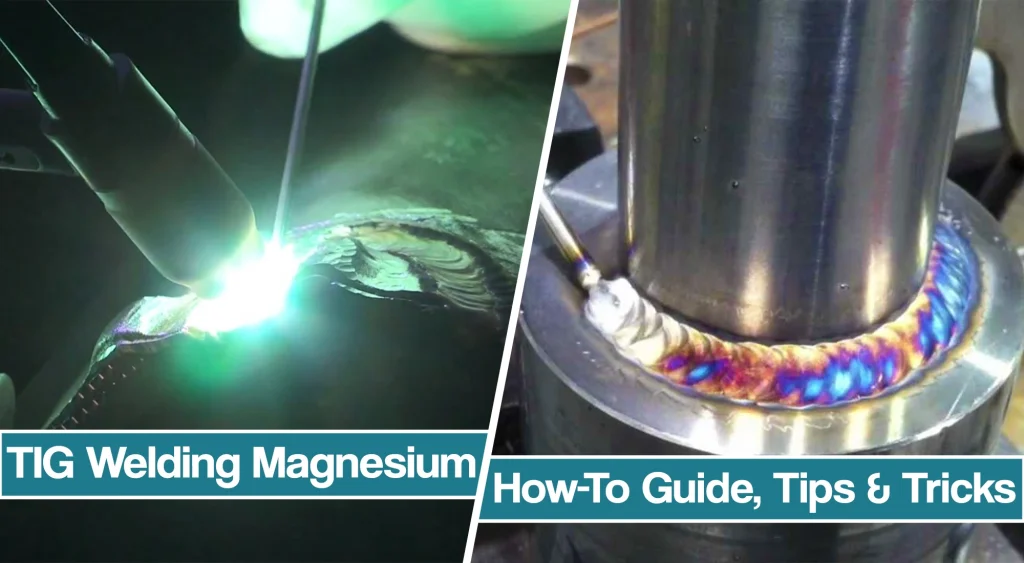
However, welding magnesium presents some unique challenges due to its low melting point and high thermal expansion coefficient. The TIG (Tungsten Inert Gas) welding process is the most commonly used method for welding magnesium alloys due to its ability to produce high-quality welds with minimal distortion.
This article will discuss the basics of TIG welding magnesium, including how to prepare the material, what filler metal to use, what protective gas is required, and safety precautions when welding magnesium.
What type of welding is used for magnesium?
- The type of welding used for magnesium is TIG (Gas Tungsten Arc Welding) welding.
How to Weld Magnesium with the TIG Welding Process? (in Short)
As we said above, TIG welding is a popular method for welding magnesium alloys due to its ability to produce high-quality welds with minimal distortion.
Before beginning the TIG welding process, it is important to prepare the material by cleaning off any dirt, oil, or other contaminants that may be present on the surface of the metal. Additionally, it is important to use a filler metal specifically designed for magnesium alloys in order to ensure optimal results.
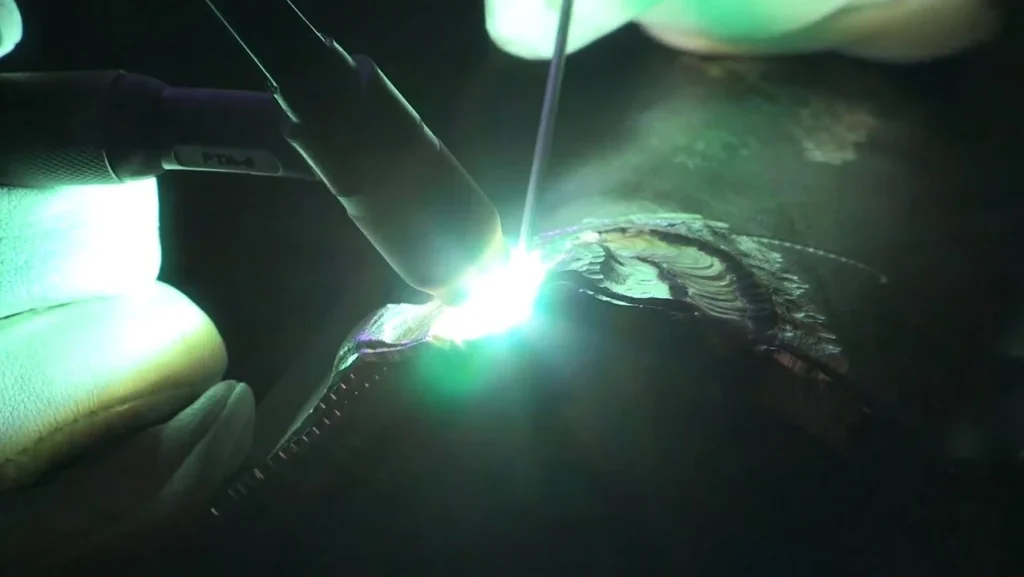
Magnesium alloys and filler wire: Generally, magnesium alloys are classified into two categories: wrought and cast. Wrought alloys are typically composed of magnesium, aluminum, and zinc while cast alloys are typically composed of magnesium, aluminum, and manganese.
The most commonly used filler metals for TIG welding wrought alloys are AZ31B (Mg-Al-Zn) and AZ61A (Mg-Al-Zn). For cast alloys, the most commonly used filler metals are AM50A (Mg-Al-Mn) and AM60B (Mg-Al-Mn). It is important to use a filler metal specifically designed for the type of alloy being welded in order to ensure optimal results. Zirconium alloyed tungsten electrodes will provide the best results.
Protective gas and safety measures: The most commonly used protective gas for TIG welding magnesium is argon, although helium can also be used in some cases. It is also important to take safety precautions when welding magnesium, this includes wearing protective clothing and using proper ventilation.
Magnesium welding properties and problems: Additionally, it is important to consider factors such as metal thicknesses and heat tolerance when TIG welding magnesium alloys in order to avoid warping or cracking of the material.
For example, thinner metals require lower heat settings than thicker metals; too much heat can cause the warping or cracking of thinner materials, while insufficient heat can lead to incomplete fusion of thicker materials. Furthermore, it is important not to exceed a maximum temperature of 725°C (1337°F) when welding magnesium alloys, as this could cause embrittlement of the material. For that reason, you should be conservative with the amperage setting on his TIG welder.
TIG welder settings for magnesium welding: The amount of amperage used when TIG welding magnesium alloys depends on the thickness of the material being welded. Generally, thinner materials require lower amperage settings, while thicker require higher amperage.
For example, for welding a 0.5mm (0.02in) thick magnesium alloy, an amperage setting of 40-60 amps is recommended; for welding a 3mm (0.12in) thick magnesium alloy, an amperage setting of 80-100 amps is recommended.
Finally, post-heat treatment of the welded joint may be necessary for ain order to achieve optimal results; this includes stress relieving and annealing processes which help reduce residual stresses and improve the ductility of the welded joint, respectively.
TIG welding provides an effective method for joining magnesium alloys with minimal distortion and excellent strength properties.
However, it is important that proper preparation techniques are followed prior to beginning the process, as well as taking safety precautions during and after welding in order to ensure optimal results are achieved while avoiding any potential hazards associated with working with this lightweight metal alloy. This was a quick look at how to weld magnesium, If you want to know every step in more detail, continue reading this article.
What happens when you weld magnesium?
- When you weld magnesium, the heat from the welding process melts and fuses together two pieces of metal. The molten material then solidifies to form a strong bond between them. During this process, sparks may be produced as well as gases that can be hazardous if not properly ventilated or contained.
- It is important to take safety precautions during magnesium welding, such as wearing protective clothing and using proper ventilation equipment in order to protect yourself from any potential hazards associated with working with molten metals. Additionally, it is important to use the correct filler materials and settings for your particular type of alloy in order to ensure a successful weld without cracking or other issues after cooling down.
How To Weld Magnesium: Preparations and Safety
Determining Magnesium alloy and its welding properties
Before magnesium welding, it is important first to determine that the material being welded is actually magnesium, an alloy of magnesium, or magnesium casting. The best way to determine that the material being welded is actually magnesium and what alloy of magnesium it is, is by using a spectrometer. This device uses X-rays to measure the chemical composition of metals and can accurately identify different alloys of magnesium. Other methods, such as spark testing or hardness testing, may also be used but are not as reliable as spectrometry for identifying specific alloys.
Pre – Weld Metal Preparation
Once this has been determined, you should then prepare the main metal piece for welding by a coarse carbide burr grinder, cleaning off any dirt or debris from its surface with a wire brush or sandpaper or soaking in sodium nitrate, calcium fluoride, and chromic acid. The next step in preparing for TIG welding magnesium involves gathering all necessary equipment, such as protective gas (usually argon), filler metal, tungsten electrodes, and an appropriate current setting based on the thickness of the material being welded.
DCEN For Magnesium Welds
The best current to weld magnesium is DCEN (Direct Current Electrode Negative). This type of current provides a more stable arc and better penetration than AC welding. It also helps reduce the risk of porosity in the welds due to its higher heat input
Pre-heating Magnesium Before Welding
It is recommended to preheat magnesium or magnesium alloys before welding. Preheating helps reduce the risk of cracking and distortion due to the rapid cooling that occurs during welding. The temperature should be between 200-400°C (392-752°F) depending on the alloy being welded. It is also important to ensure that any remaining heat in the metal after welding has been allowed to cool down slowly in order for it not to crack or distort when cooled too quickly.
Safety Measures Before Welding
It is also important to ensure that all safety precautions are taken when working with this highly flammable material; these include wearing proper clothing such as fire-resistant gloves and face shields, having adequate ventilation in place during welding operations, avoiding contact between skin and hot metals surfaces while working near them after they have been heated up during welding processes etc. Once all preparations have been made prior to starting work on a project involving TIG welding magnesium pieces together, the welder can begin the task at hand.
Can you TIG weld cast magnesium?
- Yes, you can TIG weld cast magnesium. Welding magnesium castings is challenging due to the high thermal expansion coefficient of magnesium and its low heat tolerance, but with proper preparation and safety measures, it can be done successfully.
Metal Thickness, Heat Tolerance, and Cracking
When welding magnesium with the TIG process, it is important to consider the metal thickness of the material being welded. Thicker materials require more heat input than thinner materials in order to achieve a successful weld. the higher thermal expansion coefficient of magnesium requires more heat to be applied when welding thicker sections. This is due to the fact that as temperatures increase, materials with a higher thermal expansion coefficient expand at a faster rate than those with lower coefficients.
As such, more heat must be applied in order to ensure that all parts of the material are heated evenly and completely during welding. typically between 150-200 amps for 1/8 inch thick material and up to 300 amps for 3/4 inch thick material.
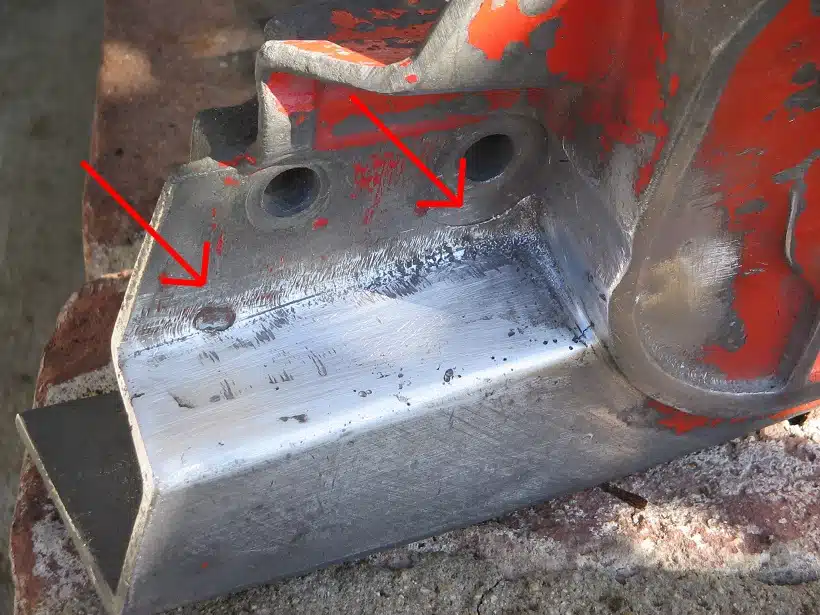
Additionally, there is no color change as the temperature approaches melting point so it can be difficult to judge how much heat has been applied without experience or specialized equipment such as an infrared thermometer or pyrometer.
It is also important to consider the risk of cracking when welding magnesium. Magnesium alloys are subject to stress corrosion, it occurs when a material is exposed to both tensile stress and a corrosive environment. This can lead to cracking in the welded metal, which can weaken the structure and cause it to fail prematurely. Stress corrosion cracking (SCC) is particularly common in magnesium alloys since they are highly reactive metal in certain environments such as salt water or acidic solutions, which can cause cracks in the welded material if not properly addressed.
To prevent this, it is important to use a low heat input and keep the arc length as short as possible while still maintaining good penetration. Additionally, preheating and post-weld heat treatment (PWHT) should be used whenever possible in order to reduce residual stresses that could lead to cracking over time. When welding magnesium-aluminum-zinc alloys such as AZ31 or AZ61, special attention must be paid due to their higher melting temperatures and a greater tendency for hot cracking than pure magnesium alloys.
In these cases, it is recommended that a lower current setting be used along with an appropriate filler rod designed specifically for these materials in order to ensure proper fusion without excessive heat input or distortion of the workpiece due to thermal expansion differences between aluminum and zinc components of the alloy compared with pure magnesium parts being welded together. Also, When welding magnesium-aluminum-zinc alloys, it is recommended to use direct current (DC) with the electrode negative. This will help reduce the risk of hot cracking and ensure proper fusion between components.
Is magnesium difficult to weld?
- Yes, magnesium is difficult to weld due to its high reactivity and low melting point. It requires special precautions, such as using a protective gas and specific filler metals in order to avoid cracking or other welding defects.
Filler Rods for TIG Welding Magnesium
When welding magnesium, the most commonly used filler rods are AZ61A and AZ92A. The choice will depend on magnesium alloy base metal, but they are designed to provide good weldability when joining clean magnesium or magnesium alloys.
The AZ61A is a low-alloyed filler wire that provides excellent corrosion resistance and strength properties, while the AZ92A is a higher-alloyed rod that offers superior mechanical properties such as ductility, toughness, and fatigue strength.
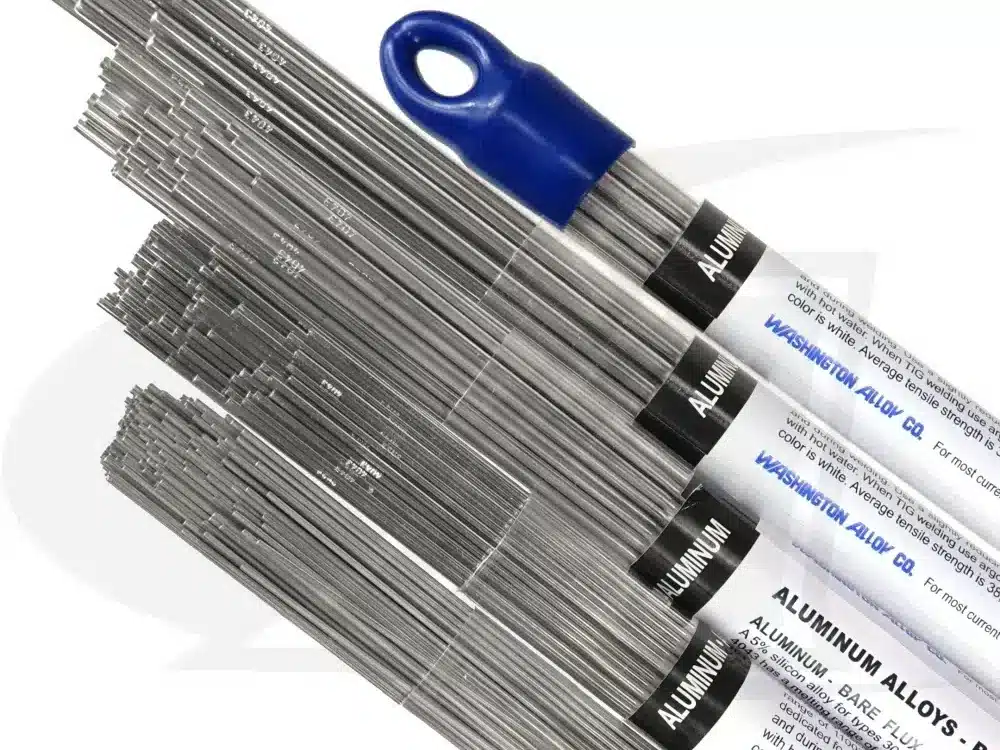
The AZ61A filler rod For TIG Magnesium Welding
The AZ61A filler rod is a low-alloyed magnesium alloy that provides excellent corrosion resistance and strength properties. It has a melting point of 590°C (1094°F) and can be used in both manual and automated welding processes with minimal risk of cracking due to its high heat tolerance levels. Additionally, it has excellent fluidity characteristics which allow it to flow easily into the joint during welding without creating any voids or porosity issues. The AZ61A also offers superior mechanical properties such as ductility, toughness, fatigue strength, and good weldability when joining clean magnesium or magnesium alloys.
The AZ92A filler rod For TIG Magnesium Welding
The AZ92A filler rod is a higher-alloyed magnesium alloy that provides superior mechanical properties such as ductility, toughness, and fatigue strength. It has a melting point of 590°C (1094°F) and can be used in both manual and automated welding processes with minimal risk of cracking due to its high heat tolerance levels. Additionally, it has excellent fluidity characteristics which allow it to flow easily into the joint during welding without creating any voids or porosity issues. The AZ92A also offers good weldability when joining clean magnesium or magnesium alloys along with improved corrosion resistance compared to the AZ61A filler rod.
ERMg5 filler rod and other alternatives For TIG Magnesium Welding
Both of these rods can be used in either manual or automated welding processes with minimal risk of cracking due to their high heat tolerance levels. Additionally, they both have excellent fluidity characteristics which allow them to flow easily into the joint during welding without creating any voids or porosity issues. In addition to these two common filler metals for TIG welding magnesium, there are other options available depending on the application requirements such as:
- ERMg5: This filler rod is a magnesium-based alloy that provides improved corrosion resistance compared to other alloys. It has a melting point of 590°C (1094°F) and can be used in both manual and automated welding processes with minimal risk of cracking due to its high heat tolerance levels.
- EZ33: This filler rod is an aluminum-magnesium alloy that offers increased tensile strength compared to other alloys. It has a melting point of 577°C (1071°F) and can be used in both manual and automated welding processes with minimal risk of cracking due to its high heat tolerance levels.
- ERMg3 (for improved corrosion resistance)
- EZ33A (for increased tensile strength)
- AZ31B (for enhanced ductility)
Each of these materials has its own unique advantages, so it’s important to select one based on your specific needs before beginning any project involving TIG welding with magnesium.
Is magnesium explosive or flammable?
- No, magnesium is not explosive or flammable during welding. However, it is important to take safety precautions when working with the metal as it can produce sparks and fumes that may be hazardous if inhaled.
Post-Treatment of the Magnesium Weld
When welding magnesium, it is important to take certain steps after the weld has been completed in order to ensure that it is strong and durable. Post-treatment of the welded magnesium includes post-heating, cleaning, and inspecting for cracks.
Post-Heating Treatment
Depending on the thickness of the metal being welded and other factors such as heat tolerance, post-heating may be necessary in order for a successful TIG welding process.
The purpose of post-heating is to reduce residual stresses caused by cooling from welding temperatures which can cause cracking or distortion if not relieved properly.
Thicker metals require more time at higher temperatures to be properly heat-treated.
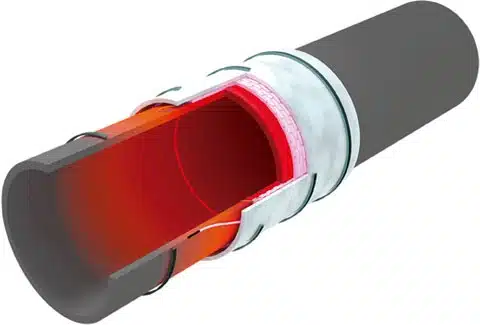
Generally speaking, metals thicker than 1/4 inch require post-heating to reduce residual stresses caused by cooling from welding temperatures.
Cleaning and Inspection for Defects
Cleaning: After completing a TIG weld on magnesium alloys or clean magnesium surfaces, it’s important to remove any slag residue left behind from the arc before moving on to inspection for cracks or other defects. This can be done with either an air gun or wire brush, depending on how much material needs to be removed from around the area where you have just finished welding.
Inspection for Cracks/Defects: Once your surface has been cleaned of any excess debris, inspect your work carefully using both visual inspection methods as well as magnifying tools like microscopes if needed. Look closely at each joint line between pieces being joined together, looking out specifically for signs of cracking, warping, porosity, etc. If anything looks suspicious, then further testing should be done using non-destructive techniques such as dye penetrant tests (DPT) or X-ray scans before proceeding with the final assembly.
Are magnesium fumes toxic?
- Yes, magnesium fumes are toxic. Inhalation of the fumes can cause irritation to the respiratory system and may lead to more serious health issues. It is important for welders to use proper ventilation during magnesium welding in order to avoid any potential health risks from exposure.
In conclusion
Welding magnesium is a complex and challenging task that requires the right preparation, the right welding equipment and the right technique. It is important to ensure the material is actually magnesium, and to use the right filler metal, protective gas, and current. Heat tolerance and cracking are two issues to be aware of when welding magnesium, and special attention is needed for magnesium-aluminum-zinc alloys.
Filler rods should be chosen carefully and post-treatment of the weld is important to ensure the weld is strong and safe. Finally, safety should be a priority when welding magnesium, as it is a hazardous material to work with. Adhering to the right measures and techniques will ensure a successful weld and help keep workers safe.
Resources
- https://www.weldingtipsandtricks.com/welding-magnesium.html
- https://vernlewis.com/welding-magnesium/
- https://www.engineeringchoice.com/how-to-tig-weld-magnesium/
- http://www.totalmateria.com/Article35.htm
- https://ewi.org/wp-content/uploads/2018/12/Kapustka-Light-Paper-Arc-Welding-of-Aluminum-and-Magnesium.pdf





